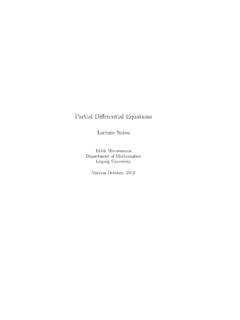Transcription of Calculus of Variations - uni-leipzig.de
1 Calculus of VariationsLecture NotesErich MiersemannDepartment of MathematicsLeipzig UniversityVersion October, 20122 Contents1 Problems inRn.. Calculus .. Nash equilibrium .. Eigenvalues .. Ordinary differential equations .. Rotationally symmetric minimal surface .. Brachistochrone .. Geodesic curves .. Critical load .. Euler s polygonal method .. Optimal control .. Partial differential equations .. Dirichlet integral .. Minimal surface equation .. Capillary equation.
2 Liquid layers .. Extremal property of an eigenvalue .. Isoperimetric problems .. Exercises .. 332 Functions of n Optima, tangent cones .. Exercises .. Necessary conditions .. Equality constraints .. Inequality constraints .. Supplement .. Exercises .. Sufficient conditions .. Equality constraints .. Inequality constraints .. Exercises .. Kuhn-Tucker theory .. Exercises .. Examples .. Maximizing of utility .. V is a polyhedron .. Eigenvalue equations.
3 Unilateral eigenvalue problems .. Noncooperative games .. Exercises .. Appendix: Convex sets .. Separation of convex sets .. Linear inequalities .. Projection on convex sets .. Lagrange multiplier rules .. Exercises .. References .. 1033 Ordinary differential Optima, tangent cones, derivatives .. Exercises .. Necessary conditions .. Free problems .. Systems of equations .. Free boundary conditions .. Transversality conditions .. Nonsmooth solutions .. Equality constraints; functionals.
4 Equality constraints; functions .. Unilateral constraints .. Exercises .. Sufficient conditions; weak minimizers .. Free problems .. Equality constraints .. Unilateral constraints .. Exercises .. Sufficient condition; strong minimizers .. Exercises .. Optimal control .. Pontryagin s maximum principle .. Examples .. Proof of Pontryagin s maximum principle; free Proof of Pontryagin s maximum principle; fixed end-point .. Exercises .. 1856 CONTENTSP refaceThese lecture notes are intented as a straightforward introduction to thecalculus of Variations which can serve as a textbook for undergraduate andbeginning graduate main body of Chapter 2 consists of well known results concerningnecessary or sufficient criteria for local minimizers, including Lagrange mul-tiplier rules, of real functions defined on a Euclideann-space.
5 Chapter 3concerns problems governed by ordinary differential content of these notes is not encyclopedic at all. For additionalreading we recommend following books: Luenberger [36], Rockafellar [50]and Rockafellar and Wets [49] for Chapter 2 and Bolza [6], Courant andHilbert [9], Giaquinta and Hildebrandt [19], Jost and Li-Jost [26], Sagan [52],Troutman [59] and Zeidler [60] for Chapter 3. Concerning variational prob - lems governed by partial differential equations see Jost and Li-Jost [26] andStruwe [57], for 1 IntroductionA huge amount of problems in the Calculus of Variations have their originin physics where one has to minimize the energy associated tothe problemunder consideration.
6 Nowadays many problems come from economics. Hereis the main point that the resources are restricted. There isno economywithout restricted basic problems in the Calculus of Variations are:(i) find minimizers,(ii) necessary conditions which have to satisfy minimizers,(iii) find solutions (extremals) which satisfy the necessarycondition,(iv) sufficient conditions which guarantee that such solutions are minimizers,(v) qualitative properties of minimizers, like regularityproperties,(vi) how depend minimizers on parameters?,(vii) stability of extremals depending on the following we consider some Problems CalculusLetf:V7 R, whereV Rnis a nonempty set.
7 Consider the problemx V:f(x) f(y) for ally there exists a solution then it follows further characterizations of thesolution which allow in many cases to calculate this solution. The main tool910 CHAPTER 1. INTRODUCTIONfor obtaining further properties is to insert foryadmissible an example letVbe a convex set. Then for giveny Vf(x) f(x+ (y x))for all real 0 1. From this inequality one derives the inequality f(x), y x 0 for ally V,provided thatf C1(Rn). Nash equilibriumIn generalization to the above problem we consider two real functionsfi(x, y),i= 1,2, defined onS1 S2, whereSi Rmi.
8 An (x , y ) S1 S2is calledaNash equilibriumiff1(x, y ) f1(x , y ) for allx S1f2(x , y) f2(x , y ) for ally functionsf1,f2are calledpayoff functionsof two players and the setsS1andS2are thestrategy setsof the players. Under additional assumptionsonfiandSithere exists a Nash equilibrium, see Nash [46]. In Section consider more general problems of noncooperative games which play animportant role in economics, for EigenvaluesConsider the eigenvalue problemAx= Bx,whereAandBare real and symmetric matrices withnrows (andncolumns).Suppose that By, y >0 for ally Rn\{0}, then the lowest eigenvalue 1is given by 1= miny Rn\{0} Ay, y By, y.
9 The higher eigenvalues can be characterized by the maximum-minimumprinciple of Courant, see Section generalization, letC Rnbe a nonempty closed convex cone with vertexat the origin. AssumeC6={0}. Then, see [37], 1= miny C\{0} Ay, y By, y ORDINARY DIFFERENTIAL EQUATIONS11is the lowest eigenvalue of the variational inequalityx C: Ax, y x Bx, y x for ally setC Rnis said to be acone with vertex atxif for anyy Cit follows thatx+t(y x) Cfor allt > Ordinary differential equationsSetE(v) = baf(x, v(x), v (x))dxand for givenua, ub RV={v C1[a, b] :v(a) =ua, v(b) =ub},where < a < b < andfis sufficiently regular.
10 One of the basicproblems in the Calculus of variation is(P)minv VE(v).That is, we seek au V:E(u) E(v) for allv Vbe a solution of (P) and assume additionallyu C2(a, b), thenddxfu (x, u(x), u (x)) =fu(x, u(x), u (x))in(a, b). Hints: For fixed C2[a, b] with (a) = (b) = 0 andreal ,| |< 0, setg( ) =E(u+ ). Sinceg(0) g( ) it followsg (0) = by parts in the formula forg (0) and the following basic lemmain the Calculus of Variations imply Euler s 1. INTRODUCTION yxbauubaFigure : Admissible variationsBasic lemma in the Calculus of C(a, b)and bah(x) (x)dx= 0for all C10(a, b).



